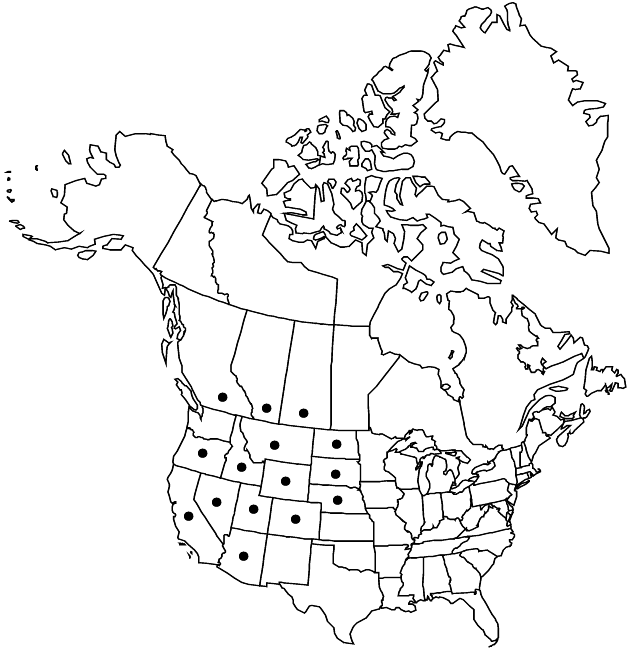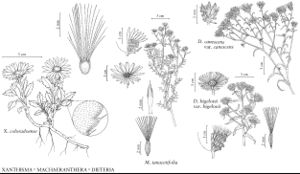Difference between revisions of "Dieteria canescens var. canescens"
FNA>Volume Importer |
FNA>Volume Importer |
||
| Line 1: | Line 1: | ||
{{Treatment/ID | {{Treatment/ID | ||
|accepted_name=Dieteria canescens var. canescens | |accepted_name=Dieteria canescens var. canescens | ||
| − | |accepted_authority= | + | |accepted_authority= |
|publications= | |publications= | ||
|basionyms= | |basionyms= | ||
| Line 7: | Line 7: | ||
|name=Machaeranthera divaricata | |name=Machaeranthera divaricata | ||
|authority=(Nuttall) Greene | |authority=(Nuttall) Greene | ||
| + | |rank=species | ||
}} {{Treatment/ID/Synonym | }} {{Treatment/ID/Synonym | ||
|name=Machaeranthera laetevirens | |name=Machaeranthera laetevirens | ||
|authority=Greene | |authority=Greene | ||
| + | |rank=species | ||
}} {{Treatment/ID/Synonym | }} {{Treatment/ID/Synonym | ||
|name=Machaeranthera latifolia | |name=Machaeranthera latifolia | ||
|authority=A. Nelson | |authority=A. Nelson | ||
| + | |rank=species | ||
}} {{Treatment/ID/Synonym | }} {{Treatment/ID/Synonym | ||
|name=Machaeranthera pulverulenta | |name=Machaeranthera pulverulenta | ||
|authority=(Nuttall) Greene | |authority=(Nuttall) Greene | ||
| + | |rank=species | ||
}} {{Treatment/ID/Synonym | }} {{Treatment/ID/Synonym | ||
|name=Machaeranthera viscosa | |name=Machaeranthera viscosa | ||
|authority=(Nuttall) Greene | |authority=(Nuttall) Greene | ||
| + | |rank=species | ||
}} | }} | ||
|hierarchy=Asteraceae;Asteraceae tribe Astereae;Dieteria;Dieteria canescens;Dieteria canescens var. canescens | |hierarchy=Asteraceae;Asteraceae tribe Astereae;Dieteria;Dieteria canescens;Dieteria canescens var. canescens | ||
| Line 34: | Line 39: | ||
|elevation=1000–3000 m | |elevation=1000–3000 m | ||
|distribution=Alta.;B.C.;Sask.;Ariz.;Calif.;Colo.;Idaho;Mont.;Nebr.;Nev.;N.Dak.;Oreg.;S.Dak.;Utah;Wyo. | |distribution=Alta.;B.C.;Sask.;Ariz.;Calif.;Colo.;Idaho;Mont.;Nebr.;Nev.;N.Dak.;Oreg.;S.Dak.;Utah;Wyo. | ||
| − | |discussion=<p>Variety canescens is the most widespread variety of this species and is encountered in the western Great Plains, Rocky Mountains, eastern Sierra <i>Nevada</i>, and intermountain regions. Its range adjoins that of all the other varieties, and intergradation is common in areas of contact. Taxa that < | + | |discussion=<p>Variety canescens is the most widespread variety of this species and is encountered in the western Great Plains, Rocky Mountains, eastern Sierra <i>Nevada</i>, and intermountain regions. Its range adjoins that of all the other varieties, and intergradation is common in areas of contact. Taxa that <i></i>var.<i> canescens</i> intergrades with include <i></i>var.<i> ambigua</i> in Utah, <i></i>var.<i> aristata</i> in Colorado and Utah, <i></i>var.<i> glabra</i> in Colorado, <i></i>var.<i> incana</i> in Idaho and Washington, <i></i>var.<i> leucanthemifolia</i> in California and Utah, <i></i>var.<i> nebraskana</i> in Nebraska and South Dakota, <i></i>var.<i> sessiliflora</i> in Idaho, <i></i>var.<i> shastensis</i> in California, <i>Nevada</i>, and Oregon, and <i></i>var.<i> ziegleri</i> in California. Variety canescens intergrades also with <i>Dieteria bigelovii</i> in Colorado, Utah, and Wyoming.</p> |
|tables= | |tables= | ||
|references= | |references= | ||
| Line 43: | Line 48: | ||
-->{{#Taxon: | -->{{#Taxon: | ||
name=Dieteria canescens var. canescens | name=Dieteria canescens var. canescens | ||
| − | + | |authority= | |
| − | |authority= | ||
|rank=variety | |rank=variety | ||
|parent rank=species | |parent rank=species | ||
| Line 58: | Line 62: | ||
|publication year= | |publication year= | ||
|special status= | |special status= | ||
| − | |source xml=https://jpend@bitbucket.org/aafc-mbb/fna-data-curation.git/src/ | + | |source xml=https://jpend@bitbucket.org/aafc-mbb/fna-data-curation.git/src/eaa6e58056e40c9ef614d8f47aea294977a1a5e9/coarse_grained_fna_xml/V19-20-21/V20_910.xml |
|tribe=Asteraceae tribe Astereae | |tribe=Asteraceae tribe Astereae | ||
|genus=Dieteria | |genus=Dieteria | ||
Revision as of 19:31, 16 December 2019
Annuals, biennials, or short-lived perennials. Stems 1+, ascending, canescent, sometimes sparsely stipitate-glandular; branches loosely spreading to ascending, flexible and curved. Mid leaf blades linear to oblanceolate. Peduncles equaling or longer than involucres. Involucres narrowly to broadly turbinate, 6–10 mm. Phyllaries in 5–10 series, spreading to reflexed, apices usually stipitate-glandular, often also canescent. Ray florets pistillate, fertile. Cypselae sparsely appressed-hairy. 2n = 8.
Phenology: Flowering Jul–Nov.
Habitat: Grasslands, pine forests, sagebrush scrublands
Elevation: 1000–3000 m
Distribution

Alta., B.C., Sask., Ariz., Calif., Colo., Idaho, Mont., Nebr., Nev., N.Dak., Oreg., S.Dak., Utah, Wyo.
Discussion
Variety canescens is the most widespread variety of this species and is encountered in the western Great Plains, Rocky Mountains, eastern Sierra Nevada, and intermountain regions. Its range adjoins that of all the other varieties, and intergradation is common in areas of contact. Taxa that var. canescens intergrades with include var. ambigua in Utah, var. aristata in Colorado and Utah, var. glabra in Colorado, var. incana in Idaho and Washington, var. leucanthemifolia in California and Utah, var. nebraskana in Nebraska and South Dakota, var. sessiliflora in Idaho, var. shastensis in California, Nevada, and Oregon, and var. ziegleri in California. Variety canescens intergrades also with Dieteria bigelovii in Colorado, Utah, and Wyoming.
Selected References
None.
